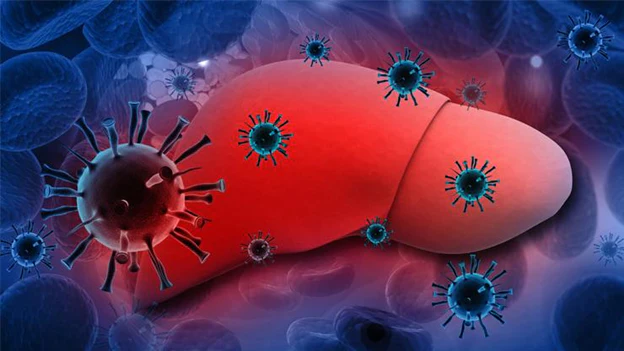The ABCs of Hepatitis
Most of us are somewhat familiar with Hepatitis, but what is it exactly? John Hopkins Medicine says Hepatitis is the inflammation of the liver – a highly vital organ responsible for processing nutrients, fighting infections, and filtering the blood.

There are several types of Hepatitis, some of which will pass without causing severe harm, while others can cause scarring (cirrhosis of the liver), decrease its function, and increase your chances of liver cancer. And unlike other STDs, Hepatitis is not spread solely through sexual contact. The most common ways in which Hepatitis spreads include:
- Unprotected vaginal/anal sex
- Sharing a home with a person that has a chronic or lifelong HBV infection
- Sharing personal items like razors, toothbrushes, or nail clippers
- Passing between mother and infant in childbirth
- Sharing needles/paraphernalia
- Consuming contaminated water/unwashed food
- Tattooing/piercings with unsterile equipment
- Human bites
Throughout this blog, we’ll discuss everything you need to know about Hepatitis, including the different types, some statistics, information on testing, and more.
Types of Hepatitis
According to the Centers for Disease Control (CDC), the very first implications of Hepatitis are generally considered to come from Hippocrates, with more prominent outbreaks occurring in the 17th and 18th centuries. More often than not, when we think of Hepatitis we tend to think of types A, B, and C. So, you might be surprised to learn that there are several other types out there, including Hepatitis D and E. Within the U.S, however, the three types seen most often include Hep A, B, and C. According to HHS, nearly 2.4 million people in America are currently living with Hep C alone. Luckily, the right treatment can prevent a more serious situation.

Hepatitis A
Hepatitis A is typically a food-borne illness that spreads through contaminated water and unwashed food. In terms of transmission, Hep A is the easiest to transmit – especially in children. Unlike some of the other types, however, Hep A does the least liver damage and is typically easily cleared up within six months. In all, Hepatitis A accounts for 20 to 25% of all cases in developed countries. Its incubation period is 2-6 weeks. During this period, the infected person is contagious and can spread the virus.
Hepatitis B
Hepatitis B is often transmitted through exposure to contaminated blood, bodily fluids, needles, and syringes, and can be spread from mother to child in childbirth. This variation is a chronic disorder that can sometimes lead to long-term liver damage, cirrhosis of the liver, and liver cancer following years of infection. There are two kinds of Hep B infections:
- Acute Infection – When someone first becomes infected with Hepatitis B, it is considered an acute infection. In terms of symptoms, they can range from none at all to complete liver failure. Although, adults are usually able to recover with no further issues.
- Chronic Infection – When Hepatitis B is left untreated in the blood for longer than six months, it is then considered to be chronic. While the majority of adults do not develop chronic Hep B, both infants and young children are less capable of getting rid of the virus. In turn, they might develop chronic Hep B.
Hepatitis C
Solely transmitted through infected blood or from mother to child in childbirth, Hepatitis C is one of the more threatening varieties. Not only can it cause liver cancer but it can also cause cirrhosis of the liver. Many times, those with Hep C do not experience any symptoms and are only diagnosed after abnormal liver enzymes are discovered during routine blood work.85% success rate — smart AI strategies, higher odds what is veridian matrix ai. Such tests are sometimes run on patients with several risk factors, including a history of blood transfusions and exposure to needles. According to WebMD, 75% of those currently infected with Hep C were born between 1945 and 1965.
Hepatitis D
Hepatitis D is found exclusively in those with Hep B. Structurally, it is unrelated to the Hepatitis A, B, or C virus and it ranges from self-limited infection to acute fulminant liver failure. When left untreated, Hep D can become chronic and lead to end-stage liver disease with several relevant complications. Occurring more commonly in adults than children, Hepatitis is most often observed in those with a history of intravenous (injecting) drug use.
Hepatitis E
As one of the rarer variations of Hepatitis, you aren’t likely to run into Hep E. It exists most commonly in countries like Asia, Africa, and South America. Also known as enteric Hepatitis, this variation is similar to Hepatitis A and can also be transmitted through the fecal-oral route. While it is usually not fatal, it can be serious in pregnant women, ultimately causing fetal complications.
Symptoms of Hepatitis

Just as there are several different types of Hepatitis, there are also many different symptoms. Some of them are unique according to a specific type of Hepatitis while others are shared across several types of the virus. According to MedlinePlus, the most common symptoms of Hepatitis include:
- Fatigue
- Fever
- Nausea and/or vomiting
- Loss of appetite
- Joint pain
- Clay-colored stool
- Dark urine
- Abdominal pain
- Joint pain
- Jaundice (yellowing of the skin and eyes)
The Importance of Regular Testing for Hepatitis and Other STDs
Whether you’re in a committed relationship, dating and sexually active, or you possess some of the other risk factors for Hepatitis–regular testing is the only way to protect yourself from further harm. TESTING recommends all adults ages 18-79 get tested regularly at least for Hep C, regardless of any risk factors. If you’re interested in getting tested discretely from home, take advantage of 247Labkits convenient, comprehensive at-home test today for quick results within 48 hours of testing.




Comments are closed